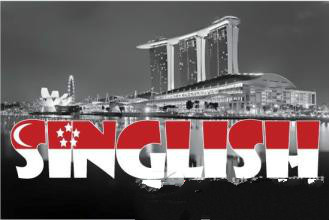(单词翻译:单击)
Singlish is seen as a national treasure or a detriment and danger – depending on whom you ask.
新加坡式英语被视作民族瑰宝抑还是视作危害和危险,这取决于你问谁。
Is that English or not? Most of Singapore's 6 million people speak it, but they don't agree either. What they do agree is that it's Singlish.
它到底是不是英文?新加坡六百万人口中的大部分都在讲,但是他们自己也不认同它。他们认为那是新加坡式英语。
Singapore is a small island at the southern tip of the Malay Peninsula, and it was originally populated by Malays.
新加坡是马来半岛南部的一个小岛,它起初居住着马来人。
After a British trading post was established there in 1819, many of the traders who arrived were from different Chinese ethnicities: Hokkien, Cantonese, Teochew, Hakka, Hainanese.
自1819年英国在这里建立贸易点后,很多来自中国各民族的商人汇聚这里:福建人、广东人、潮州人、客家人、海南人。
Some also came from India and Sri Lanka, especially Tamils.
还有一些来自印度和斯里兰卡,尤其是泰米尔人。

By the early 20th Century, there was a pidgin used in trading, but it wasn't based on English or Chinese – it was called Bazaar Malay.
20世纪初,贸易往来有用皮钦语,但是这种语言不源于英文或者中文--它叫做市井马来语。
Education was not universal; the better-off families paid to send their children to English-speaking schools to advance their career prospects, and it was in this context that the seeds of Singlish were sown.
当时教育并不是普遍现象。家境富裕的家庭花钱送他们的孩子到英文学校推进职业前景,在这种背景下,播下了新加坡式英语的种子。
Singlish didn't show up first as a pidgin, a lingua franca used in trade. It came about as an adapted version of English used by students in English-language schools who spoke other languages at home.
在皮钦语演化的初期,并没有新加坡式英语,皮钦语是一种用于贸易的法国语言。当学生们在英文学校讲话时候,出现了这种改编的英文版本,这些学生在是家中讲其他语言。
Which means that from the beginning, it had the air of 'not-quite-right' English, a version that the students knew wasn't 'proper' – but was functional and had more cultural connection for them.
这就意味着从一开始,就有一种"并不是很正确的"英文,一种学生知道并不是"很准确"的英文版本--但是它的适用性很广泛,也更具有文化关联性。
After World War Two, universal free education was instituted in Singapore, and starting in the 1960s it was provided on an 'English plus mother tongue' basis: the students would take their classes in English, plus a class in one of the three mother tongues of Singapore – Malay, Tamil, and Chinese ('Chinese' in this case meaning not Hokkien or Cantonese but Mandarin: the most prestigious kind, and the most useful for business).
第二次世界大战以后,新加坡创立了全民免费教育,20世纪70年代开始,开始英文加母语教育:学生使用英文上课,加上新加坡三门母语之一—马来语,泰米尔语或者中文(这里的"中文"不是福建话或者广东话,而是普通话——最权威,商业使用最广泛的中文语种)。
The schools were the soil in which Singlish sprouted, and it has now spread through all of everyday life.
学校是新加坡式英语萌芽的地方,如今,新加坡式英语覆盖了每天的日常生活。
The population of Singapore today is more than 75% Chinese, about 15% Malay, about 8% 'Indian' (mainly Tamil), and roughly 2% other origins, but about half of the population now speak English (or Singlish) at home.
今天的新加坡人口75%都是中国人,约15%是马来人,8%是印度人(主要是泰米尔人),大约2%源自其他民族,但是国内只有大约一半的人讲英文(或者是新加坡式英语)。
And Singlish is the neutral language between members of different ethnic groups. It is undeniably a central expression of Singaporean culture, vibrant, loaded with references from the cultural backgrounds of Singaporeans.
新加坡式英语是不同种族间的中性语言,毋庸置疑是对新加坡文化的核心表达,这种语言具有生命力,富含新加坡人文化背景的注脚。
And it is still thought of by many Singaporeans as 'bad English' even as they use it themselves.
尽管有些新加坡人使用它,但是仍然觉得是"不好的英文"。
Must Singlish ultimately die for Singapore to thrive? Some have said so.
为了新加坡的兴旺,新加坡式英语最终必须消亡吗?一些人说它应该消亡。
In 1999, Jaime Ee, in a column in The Straits Times, wrote that Singlish "became an identity thing for us, something that we created ourselves and gave us a sense of rootedness even if nobody else could understand it except us.
1999年,海峡时报专栏的Jaime Ee写道,新加坡式英语已经成为了我们的一种身份,一种我们自己创造的东西,尽管除了我们以外他人无法理解,但是却给了我们一种有根的感觉。
Unfortunately, if we want to become a global economy, we have to give this up, and in a way, give up a bit of our identity."
不幸地是,如果我们想要成为全球化的经济体,我们必须放弃它,在某种程度上来说,就是放弃一点儿我们的身份。"


